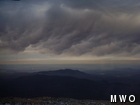Mammatus clouds
2010-11-16 20:32:24.000 – Erica Sandschulte, Summit Intern
Mammatus clouds
MAMMATUS clouds. The last time I witnessed mammatus clouds was the September of my senior year of college in Arizona; it was towards the end of Monsoon season. I remember it clearly, I was outside warming up for soccer practice, in the distance dark cumulonimbus clouds rolled in from the east over the northern part of Mogollon Rim. Several large opaque like lobes covered the sky, the clouds had a green tint, and were moving in quickly. Seeing these uncommon clouds I knew it would be the onset of what would be a storm. Fifteen minutes later hail started pouring down and minutes after that came thunder and lightning. By this time I had taken cover with my fellow teammates. We stood in awe of the incredible storm that was taking place.
Not all mammatus clouds indicate that there will be a sever storm nor do they produce sever weather. They can often be found with altocumulus, altostratus, and stratocumulus clouds. Living on the Rockpile for a week at a time, you see several types clouds and Monday I observed mammatus clouds to our north. These were not signifying the onset of a storm, just the passing of a weak cold front. If you had the chance to step outside early Monday afternoon you may have noticed the towering cumulus clouds surrounding the summits. Temperatures did drop slightly through the day and the summits saw light snow showers-they only last 10 minutes, but it was exciting to see a few snow showers as well as mammatus clouds!
Erica Sandschulte, Summit Intern
Team Flags Return for Seek the Peak’s 25th Anniversary
Team Flags Return for Seek the Peak's 25th Anniversary By MWOBS Staff Mount Washington Observatory is looking forward to continuing a much-loved tradition for Seek the Peak’s 25th Anniversary: Team flags. In inviting teams
Meet Summer Interns Zakiya, Max and Maddie
Meet Summer Interns Zakiya, Max and Maddie By MWOBS Staff We are excited to welcome six teammates to the summit of Mount Washington this summer! During their internship, these students and graduates will play
Saying Goodbye to the Summit
Saying Goodbye to the Summit By Alexis George After an extraordinary last three years working as a Weather Observer and Meteorologist, I am excited to pursue a different career. As sad I as am






